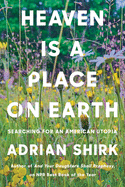
Adrian Shirk (And Your Daughters Shall Prophesy) delves into the enduring allure of utopian communities in Heaven Is a Place on Earth, her second entrancing study of religious history. Following scholars such as José Esteban Muñoz, Shirk defines a utopia as "any gesture that points to a better future." Utopian experiments, she writes, often arise in response to "times of economic and social precarity" to counter the brokenness of capitalism and the emptiness of individualism. Certain sites seem to attract layers of utopian projects, such as Western New York, home to the Shakers, the Oneida Community and the Fourierists.
Shirk visits intentional communities, such as the Bruderhofs in the Catskills, the Simple Way in Philadelphia and The Farm in Tennessee. Brief "utopianotes" throughout the book describe pilgrimages to sites of former communes and recount her experiences with communal living. She describes living as a college professor in an "Adjunct Flophouse" in Brooklyn and attending a progressive church that felt like home. Later, she and her husband establish a Catskills compound, the Mutual Aid Society, where artists and acquaintances undertake long-term residency for minimal rent (and where she lives with her family today).
Points of reference are wide-ranging: early Christians' communal living in the biblical book of Acts, Nathaniel Hawthorne's utopia-themed The Blithedale Romance, the 1987 Belinda Carlisle song that serves as the book's title. Amusing asides tell the stories of utopia founders, visitors and "groupies," such as Marguerite Young. Shirk shares her personal struggles with failure, idealism and privilege, noting that these projects generally are undertaken by white people and require financial security. She consistently grounds the historical and theoretical material in this flowing narrative. --Rebecca Foster, freelance reviewer, proofreader and blogger at Bookish Beck

